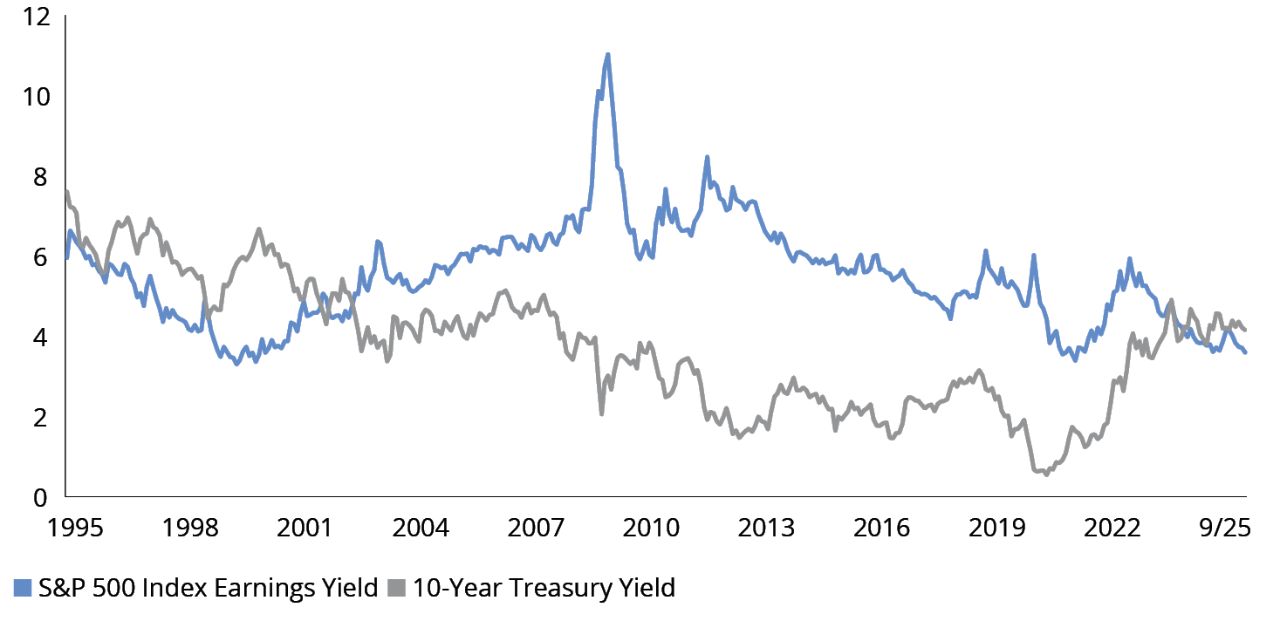Comparing the return potential of stocks vs. bonds is a necessary task for investors, but it sometimes requires going beyond traditional metrics. Fortunately, earnings yield can be used to help evaluate the relative attractiveness of equities to fixed income.
Earnings Yield vs. Treasury Yield
Earnings yield, calculated as the inverse of the price-to-earnings ratio,1 reflects the percentage earnings generated for each dollar invested in a stock over the past 12 months. By comparing the earnings yield for the S&P 500 Index2 with the yield from a 10-year US Treasury, investors can assess whether equities or bonds may be positioned to offer superior return potential, especially in environments marked by shifting interest rates and market volatility.
FIGURE 1
Treasury Yields Recently Pulled Ahead of Equity Earnings Yields
S&P 500 Index Earnings Yield and 10-Year Treasury Yield (%)

Chart Data: 1995-9/30/25. Past performance does not guarantee future results. Indices are unmanaged and not available for direct investment. Data Sources: FactSet and Hartford Funds, 10/25.
The chart shown above illustrates a notable trend: Since early 2024, the yield on 10-year US Treasuries has exceeded the earnings yield of the S&P 500 Index. This inversion is significant, as it suggests that fixed-income investments may currently offer more attractive returns than equities—a dynamic not seen since the dot-com bubble era when equity prices surged relative to earnings.
The current environment, shaped by Federal Reserve policy shifts and inflationary pressures, has elevated Treasury yields, which may make them a compelling option for investors seeking income and lower volatility relative to equities.
A Competitive Alternative?
Equities have delivered significant growth in recent years, rewarding long-term investors. However, future equity returns may be less compelling compared to bonds.
If portfolios have become heavily weighted toward equities, it may be time to consider diversifying or rebalancing into bonds. This can help manage risk and position portfolios for a more balanced return outlook.
To learn more about balancing risk in your portfolio, talk to your financial professional.
1 The price-to-earnings ratio measures a company’s share price relative to its earnings-per-share and helps assess the relative value of a company’s stock.
2 S&P 500 Index is a market capitalization-weighted price index composed of 500 widely held common stocks.
Important Risks: Investing involves risk, including the possible loss of principal. • Fixed income security risks include credit, liquidity, call, duration, and interest-rate risk. As interest rates rise, bond prices generally fall. • Diversification does not ensure a profit or protect against a loss in declining market.
This information should not be considered investment advice or a recommendation to buy/sell any security. In addition, it does not take into account the specific investment objectives, tax and financial condition of any specific person. This information has been prepared from sources believed reliable, but the accuracy and completeness of the information cannot be guaranteed. This material and/or its contents are current at the time of writing and are subject to change without notice.






